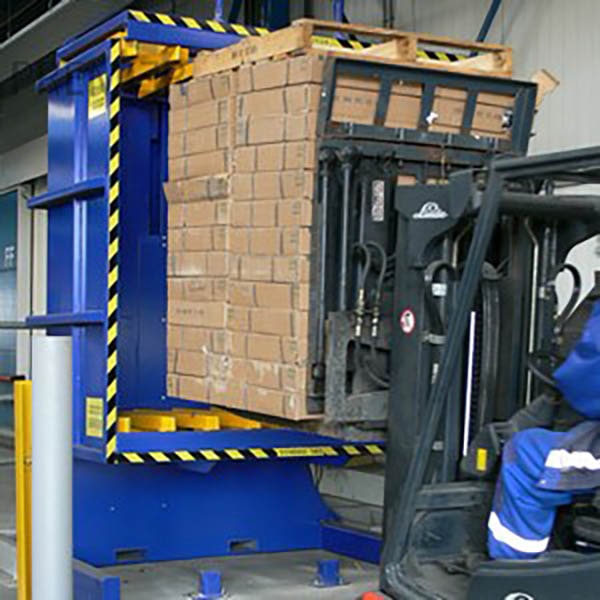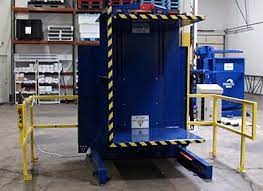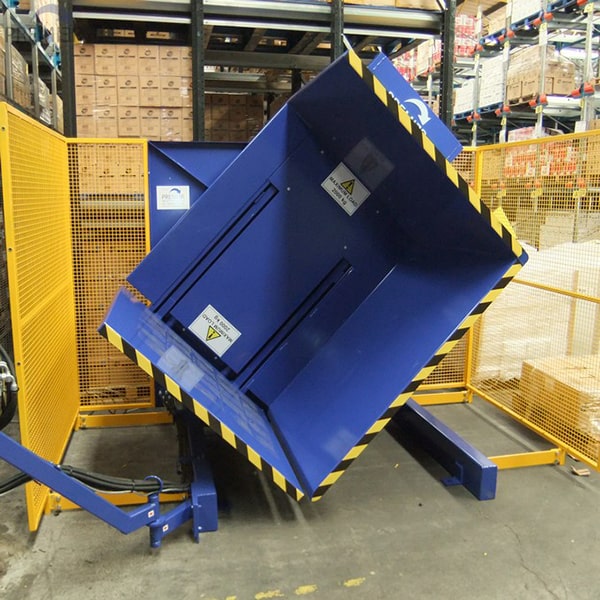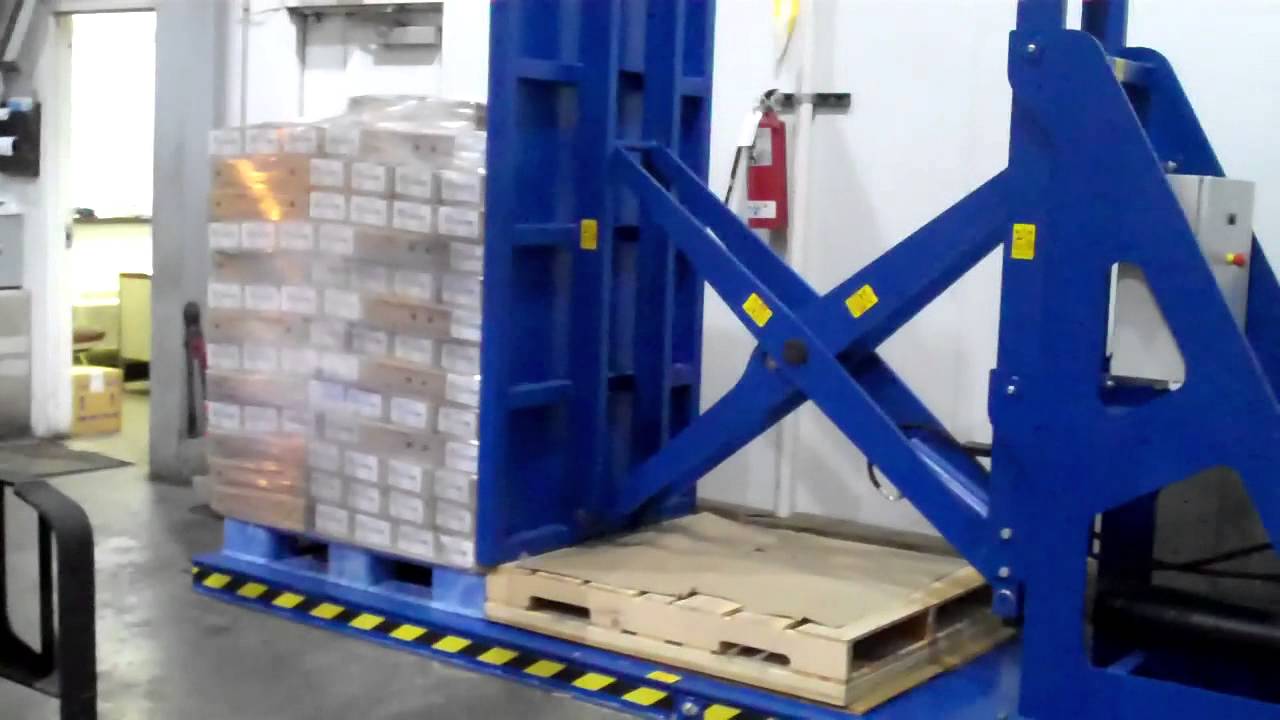How Pallet Inverters Solve rugged designs for cold storage and high throughput in Russia?
Managing logistics in an extreme environment like a Russian winter is a massive challenge. Standard equipment often fails when temperatures plummet. Steel becomes brittle, oils thicken, and operations grind to a halt. For any business that relies on high throughput, like a busy steel mill or a cold storage warehouse, this isn't just an inconvenience—it's a critical failure that costs money and damages reputations. Imagine a pallet of valuable goods stuck on a frozen machine in a -30°C facility. The deadline is approaching, your team is struggling, and every minute of downtime adds to a growing bill. This is a scenario I've seen play out, and it's a manager's worst nightmare. The solution isn't to hope for the best; it's to invest in equipment specifically engineered for these brutal conditions. A pallet inverter with a rugged, purpose-built design is the key to maintaining efficiency and reliability when the cold sets in.
A ruggedly designed pallet inverter solves challenges in Russian cold storage and high-throughput environments by using specialized materials like low-temperature steel, hydraulic systems with cold-resistant fluids, and reinforced frames. These features ensure reliable operation at sub-zero temperatures. At the same time, powerful motors and automated controls enable rapid pallet exchange cycles, meeting demanding throughput targets without compromising safety or durability.

When I started my journey in the packing machine industry, I quickly learned that a machine's spec sheet only tells part of the story. The real test is how it performs under pressure, day in and day out, in the real world. A freezing warehouse in Siberia is about as real-world as it gets. It's not enough for a machine to just work; it has to be tough, reliable, and efficient. It's the engineering choices made behind the scenes—the type of steel used, the quality of the hydraulic system, the protection for the electronics—that separate a machine that survives from one that thrives. Let's look closer at the specific design elements that make these pallet inverters a vital tool for any operation facing extreme cold and high demand.
How do rugged pallet inverters withstand the harsh conditions of Russian cold storage?
When you operate in a cold storage facility, especially in a place with a climate like Russia's, standard machinery is a liability. The intense cold attacks equipment at its weakest points. Ordinary steel can become as fragile as glass, and hydraulic oil can turn into thick sludge, rendering the machine useless. I've heard stories from clients who faced catastrophic failures—a fractured frame, a burst hydraulic line—that not only caused massive downtime but also posed a serious risk to their employees and products. The financial impact of such failures, from lost product to emergency repairs, can be staggering. The solution is not to repair machines constantly but to invest in equipment built from the ground up to handle the cold. It requires a deep understanding of material science and engineering principles designed for low-temperature applications.
A rugged pallet inverter withstands harsh cold storage conditions by incorporating low-temperature carbon steel for its frame, using hydraulic oils with a low pour point, and sealing all electrical components to IP65 standards or higher. This prevents moisture ingress and freezing. Additionally, features like heaters for hydraulic tanks and control cabinets are often integrated to ensure consistent, reliable performance even when the temperature drops far below zero.

In my years of designing and building packing machinery, I've learned that you must anticipate the environment. You cannot fight the cold; you have to engineer for it. This means looking at every single component, from the largest structural beam to the smallest electrical connector, and asking, "Will this fail at -30°C?" This proactive approach is what defines a truly rugged machine. It’s about building in resilience at every stage of the manufacturing process.
Material Selection: The Backbone of Durability
The choice of steel is the most critical factor for equipment operating in the cold. Standard carbon steel, like the commonly used Q235, undergoes a ductile-to-brittle transition at low temperatures. This means it loses its ability to deform under stress and can fracture suddenly without warning. For a pallet inverter handling loads of a ton or more, such a failure would be disastrous.
That’s why for our cold-storage models, we use special low-temperature steel, such as Q345D. This grade is designed to maintain its ductility and toughness even at temperatures down to -20°C or -40°C. It costs more, but it is an essential investment in safety and reliability. The frame, the clamping arms, and all load-bearing components must be made from this material. It’s a non-negotiable part of the design.
Hydraulic System Integrity in the Cold
The hydraulic system is the muscle of the pallet inverter. In extreme cold, standard hydraulic fluid thickens, increasing its viscosity. This "sluggish" oil flows slowly, causing the machine's movements to be jerky and slow, which completely kills throughput. In the worst cases, the pressure required to move the thick fluid can strain the pump and even cause lines to burst.
To prevent this, we use synthetic hydraulic fluids with a very low pour point and a stable viscosity index. This ensures the fluid remains effective even in sub-zero conditions. Furthermore, we often integrate oil tank heaters. These small, thermostatically controlled heaters keep the hydraulic fluid at an optimal operating temperature, ensuring smooth, consistent, and fast performance from the moment the machine is switched on.
Protecting Electrical and Electronic Components
Moisture is another enemy in cold environments. Temperature fluctuations can cause condensation to form inside control cabinets and on electrical components. This moisture can then freeze, damaging circuits, causing short circuits, or preventing switches and sensors from working correctly.
All our cold-storage pallet inverters feature electrical enclosures with an IP65 rating or higher. This means they are completely sealed against dust and protected from low-pressure water jets, which also prevents moisture-laden air from getting inside. We use high-quality cabling with insulation that remains flexible in the cold, preventing it from cracking. All sensors, like photoelectric eyes, are sealed units designed for low-temperature operation.
| Feature | Standard Pallet Inverter | Cold-Storage Rated Inverter | Benefit in Cold Environments |
|---|---|---|---|
| Frame Steel | Q235 Carbon Steel | Q345D Low-Temp Steel | Prevents brittle fracture, ensures structural integrity. |
| Hydraulic Fluid | Standard Mineral Oil | Low-Temp Synthetic Fluid | Maintains low viscosity for smooth, fast operation. |
| System Heaters | None | Hydraulic Tank & Cabinet Heaters | Ensures optimal fluid and electronic temperatures. |
| Electrical Enclosure | IP54 | IP65 or higher | Protects against condensation, moisture, and dust. |
| Cabling | Standard PVC | Cold-Resistant Insulation | Stays flexible, prevents cracking and failure. |
What design features enable pallet inverters to achieve high throughput?
In any busy production facility or distribution center, speed is critical. A slow process at any point in the line creates a bottleneck that slows down everything else. When it comes to pallet handling, every second saved matters. It translates directly to more goods shipped, lower labor costs, and better overall efficiency. But speed cannot come at the cost of safety or reliability. A machine that is fast but frequently damages products or requires constant maintenance is not a solution. The goal is to achieve high throughput consistently and safely.
Pallet inverters achieve high throughput through a combination of powerful hydraulic or electric motors for rapid rotation, dual clamping plates for secure and fast load handling, and intuitive, automated control systems. These systems minimize operator input and cycle time. Features like adjustable clamping pressure and photoelectric sensors for automatic positioning further streamline the process, allowing for a complete pallet exchange cycle in as little as 30 to 45 seconds.

From my experience running a factory, I know that true efficiency comes from looking at the entire process. It’s not just about how fast one part moves. It's about how all the parts work together in a smooth, coordinated sequence. Designing a high-throughput pallet inverter is a perfect example of this. We focus on optimizing every single step of the cycle—from the moment the forklift places the pallet to the moment it picks up the newly transferred load.
The Power and Speed of the Drive System
The heart of a high-throughput machine is its drive system. This is what provides the speed and power for the rotation. We carefully select the motor and hydraulic pump (or electric motor and gearbox) to provide the optimal balance of speed and torque. A more powerful motor can rotate the load faster, but this must be controlled.
A key feature is the use of soft-start and soft-stop programming in the PLC (Programmable Logic Controller). The inverter doesn't just slam from zero to full speed. It accelerates smoothly and then decelerates smoothly as it approaches the 180-degree point. This controlled motion protects the product from G-force damage and reduces stress on the machine's mechanical components, contributing to a longer lifespan even under constant use.
Optimizing the Clamping and Rotation Cycle
The speed of a pallet exchange is determined by more than just the rotation. The clamping and release actions are just as important. Our high-throughput models feature powerful hydraulic cylinders that can open and close the clamping platforms quickly. The system is designed to minimize wasted motion.
Furthermore, we use adjustable clamping pressure. This is crucial. For a heavy, stable load like steel parts, you can use high pressure for a secure grip. For a lighter, more fragile load like boxes of electronics, you can reduce the pressure to avoid crushing the product. Having the ability to preset these pressures in the control system for different product types means the operator doesn't have to guess. They simply select the program, and the machine uses the optimal settings, saving time and preventing errors.
Automation and Control Logic
Automation is the final piece of the puzzle for achieving high throughput. A manual process is only as fast as its operator. By automating key steps, we remove variability and hesitation. Our pallet inverters can be equipped with photoelectric sensors that detect when a pallet is correctly positioned, allowing the machine to begin the clamping cycle automatically.
For fully integrated lines, the pallet inverter can communicate with upstream and downstream conveyors. It can receive a pallet from an infeed conveyor, perform the inversion, and then discharge the load onto an outfeed conveyor without any human intervention. This is the level of automation that clients like Javier, who are pushing for digital transformation and MES integration, are looking for. It turns the pallet inverter from a standalone machine into an intelligent node in a larger, optimized logistics system.
| Design Element | Contribution to High Throughput | Impact on Operations |
|---|---|---|
| Powerful Drive System | Reduces rotation time from 30s to <15s. | Increases the number of pallets handled per hour. |
| Soft Start/Stop Control | Allows high speed without damaging the load. | Reduces product damage and machine wear. |
| Fast-Acting Clamps | Minimizes time spent opening/closing. | Shortens the overall cycle time by several seconds. |
| Automated Controls | Eliminates operator hesitation and manual steps. | Ensures consistent, repeatable, and fast cycles. |
Why is a custom pallet inverter a better choice than a standard model for specialized operations?
Many factories and warehouses have unique needs. Their products might be unusually large, heavy, or fragile. Their pallets might be non-standard sizes. Their workflow might require a machine to fit into a tight, specific space. In these situations, a standard, off-the-shelf pallet inverter is often a poor fit. Trying to force a standard machine to do a specialized job usually leads to compromises—compromises in efficiency, safety, and product integrity.
This is a lesson I learned early in my career. A one-size-fits-all approach rarely delivers the best results. A client might end up with a machine that is too slow, damages their product, or creates a safety hazard because it wasn't designed for their specific application. That's why I believe a custom-built machine isn't a luxury; it's a strategic investment. It ensures a perfect fit for your operation, maximizing performance and delivering a much better return.
A custom pallet inverter is a better choice for specialized operations because it can be engineered to handle specific load dimensions, weight capacities, and environmental conditions. Customization allows for unique features like stainless steel construction for hygienic applications, wider opening ranges for non-standard pallets, or direct integration with existing automated systems. This ensures optimal performance and safety where a standard model would be inefficient or impractical.

I always see myself not just as a supplier, but as a partner to my clients. Someone like Javier Morales, who runs a massive steel mill, isn't just buying a machine; he's investing in a solution to a problem. My job is to listen to that problem and use my engineering experience to design the perfect tool for the job. This collaborative approach is what building a total solution is all about.
Tailoring for Unique Load Characteristics
The first area for customization is always the load itself. A standard pallet inverter is typically designed for a common pallet size, like 1200x1000mm, and a weight of up to 1500kg. But what if you are handling steel coils that weigh 3000kg? Or large, unstable stacks of paper?
For heavy loads, we must reinforce the entire structure. This means a stronger frame, larger bearings, and a more powerful hydraulic system. The clamping platforms may need a different surface, perhaps a rubberized one, to securely grip a smooth steel coil. For very tall or unstable loads, the clamping mechanism needs a wider opening range and may require a top press to gently stabilize the product before and during rotation. Customizing these elements is crucial for handling the load safely and without damage.
Adapting to Environmental and Regulatory Needs
The operating environment dictates many design choices. We already discussed cold storage, but there are many other special environments. In the food and pharmaceutical industries, hygiene is paramount. For these clients, we build pallet inverters from 304 or 316 stainless steel. All welds are ground smooth to prevent bacteria from collecting, and we use food-grade hydraulic fluid.
In facilities that handle flammable materials, such as chemical plants, there is a risk of explosion. For these applications, we must build explosion-proof machines. This means all electrical components—motors, sensors, switches, control cabinets—must be certified to the required safety standards (like ATEX or IECEx) to ensure they cannot create a spark. A standard machine would be dangerously unsafe in such an environment.
Integration with Your Specific Workflow
A machine doesn't exist in a vacuum. It has to fit into your facility and your process. Customization often involves physical modifications to integrate with an existing workflow. For example, a client might have a conveyor system that is at a specific height. We can design the pallet inverter so that its loading and unloading platforms match that height perfectly, allowing for a seamless transition.
This also extends to automation. A client might have a centralized Manufacturing Execution System (MES) that controls the entire plant. We can design the pallet inverter's control system to communicate directly with the MES. The MES can send commands to the inverter to start a cycle and the inverter can send back data on its status, number of cycles completed, and any potential faults. This level of integration is a cornerstone of the modern, digitally transformed factory that leaders like Javier are building.
| Customization Area | Standard Model Limitation | Custom Solution Example | Benefit for a Steel Mill (like Javier's) |
|---|---|---|---|
| Load Capacity | Max 1500kg | Reinforced frame for 3000kg+ capacity | Safely handles heavy steel coils or wire bundles. |
| Load Dimensions | Fixed for standard pallets | Wider opening range for oversized loads | Can handle various product sizes without manual adjustment. |
| Control System | Standalone operation | MES/ERP integration | Provides real-time data for production tracking and efficiency analysis. |
| Operating Env. | Indoor, temperate | Ruggedized for dust, heat, and vibration | Ensures long life and reliability in the harsh steel mill environment. |
How does the right pallet inverter impact overall operational efficiency and ROI?
Any significant equipment purchase is a capital investment, and for a business leader like Javier, that investment has to be justified with a clear Return on Investment (ROI). It's not enough for a machine to simply work; it must contribute to the bottom line by improving efficiency and reducing costs. Choosing the wrong machine—or choosing to stick with slow, manual processes—is a costly mistake. The expenses associated with high labor costs, product damage, and workplace injuries from manual handling add up quickly and eat into your profit margins.
The right pallet inverter is not a cost center; it is a powerful tool for driving profitability. It delivers a measurable ROI by directly attacking key operational costs. By automating a physically demanding and time-consuming task, it frees up your workforce, protects your products, and speeds up your entire supply chain. It’s a strategic investment in a more efficient, safer, and more profitable operation.
The right pallet inverter directly impacts operational efficiency and ROI by drastically reducing the labor costs tied to manual pallet swapping, minimizing product damage during handling, and accelerating the entire logistics process. It also significantly improves worker safety, which reduces costs related to injuries and insurance claims. These combined savings often lead to a full payback on the investment in under 24 months.

When I work with clients, especially those with an engineering or business background, I always focus on the numbers. The decision to invest becomes easy when the financial benefits are clear. We can sit down and calculate the expected savings, and the results are often very compelling. It’s about shifting from seeing the machine's price tag to understanding its long-term value.
Calculating the Tangible ROI
The financial case for a pallet inverter is built on several key areas of cost reduction. Let's break it down:
- Labor Savings: This is the most direct saving. Manually transferring a load from one pallet to another can take two workers 10-15 minutes. A pallet inverter can do the same job with one operator in about one minute. You can easily calculate the annual savings by multiplying the time saved per pallet by your labor rate and the number of pallets you handle per year. This alone is often enough to justify the investment.
- Product Damage Reduction: Manual handling is risky. Products get dropped, boxes get crushed, and loads become unstable. A pallet inverter handles the entire load in a single, smooth, controlled motion. The reduction in damaged goods can be significant, especially if you are handling high-value products.
- Pallet Cost Savings: Many companies ship products on high-quality, expensive pallets but use cheaper, lower-quality pallets for in-house storage. A pallet inverter makes it fast and easy to switch loads from your internal pallets to your shipping pallets just before dispatch. This allows you to keep your expensive pallets in-house, reducing loss and replacement costs.
The Intangible Benefits are Real
Beyond the hard numbers, there are other powerful benefits.
- Improved Worker Safety: Manually lifting and restacking heavy loads is a leading cause of back injuries and other musculoskeletal disorders. A pallet inverter eliminates this hazardous manual task. This reduces the risk of injuries, lowers insurance premiums, and improves employee morale. A safer workplace is a more productive workplace.
- Enhanced Operational Speed and Flexibility: With a pallet inverter, your team can respond to changing demands much faster. Need to quickly switch a batch of products to different pallets for an urgent export order? It’s a fast, simple process. This agility is a significant competitive advantage.
A Strategic Asset for Growth
For a forward-thinking leader like Javier, who aims to increase capacity utilization and reduce operational costs, a pallet inverter is a strategic asset. It allows your operation to handle a higher volume of goods without needing to proportionally increase your workforce. It is a tool that breaks the linear relationship between volume and labor cost. By automating a key logistics task, you build a more scalable and efficient operation, positioning your company for future growth while improving your profit margins today.
| Cost Area | Manual Process | With Pallet Inverter | Annual Savings Example (50 pallets/day) |
|---|---|---|---|
| Labor | 2 workers, 10 minutes/pallet | 1 worker, 1.5 minutes/pallet | > $50,000 |
| Product Damage | 1-2% of value | <0.2% of value | > $15,000 |
| Worker Safety | High risk of injury | Risk virtually eliminated | Reduced insurance & downtime costs |
| Total ROI | - | Payback Period < 2 Years | Significant contribution to profit margin |
Conclusion
Choosing the right pallet inverter is a strategic decision. It ensures your operations run smoothly, safely, and profitably, even in the most demanding environments. We can help you build your solution.


